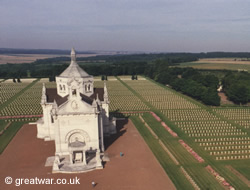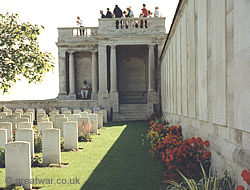St. Mary's A.D.S. Cemetery, Haisnes, France
There are over 1,800 burials from the First World War in St. Mary's A.D.S. Cemetery. Of these burials there are 218 identified casualties. Most of the burials are for casualties killed at the Battle of Loos (25 September - 13 October 1915).
- Origin of St. Mary's A.D.S. Cemetery
- Canadian Casualties
- Grave of Lieutenant John Kipling, Irish Guards
- Rudyard Kipling and the Imperial War Graves Commission
- Design of St. Mary's A.D.S. Cemetery
- French Military Cemetery Relocated
- Location of St. Mary's A.D.S. Cemetery
Origin of St. Mary's A.D.S. Cemetery
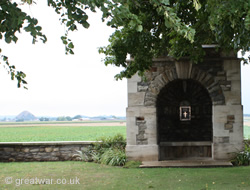
|
In 1919 the Loos battlefield was cleared and burial parties removed the remains of many hundreds of British and Canadian soldiers from the battlefield area north of Loos village. This cemetery was created by the concentration of these graves into one site after the war. Almost 2,000 casualties were buried here from that time.
Most casualties were found in isolated graves or small burial plots on the battlefield. Nine soldiers were relocated from a burial site at the Loos Communal Cemetery, the original civilian cemetery for the village located in the south-west corner of Loos. They had originally been buried there in February 1916 but the cemetery was badly damaged by artillery shellfire by the end of the war and their graves were relocated.
Special Memorials
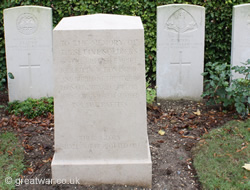
|
To the left, right and rear of the War Stone at the southern end of the cemetery there are Special Memorials. Left and right of the War Stone the special memorials are to soldiers believed to be buried among the casualties brought into this cemetery.
To the rear of the War Stone five headstones and a Special Memorial stone commemorate five soldiers from the United Kingdom who were known to be buried in Loos Communal Cemetery during the war, but whose graves were destroyed by artillery shellfire before the Armistice in November 1918.
The majority of the burials in this cemetery were killed or died of wounds on the battlefield during the Battle of Loos (25 September-13 October 1915). Some graves, known and unknown, are also for British and Canadian servicemen who died in the area after that time until the Armistice. The Allied and German Front Lines more or less stabilized here for the following three years after the Battle of Loos until the later months of 1918 when Allied offensives gradually pushed the Germans eastwards in the Allied Advance to Victory (8 August-11 November 1918).
Canadian Casualties
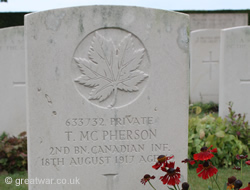
|
In mid 1917 the Canadian Corps mounted an offensive against the German line east of Loos in the Battle of Hill 70 (15-25 August 1917), with the objective to draw the Germans to this place at the start of the Allied offensive further north in the Ypres Salient. The Canadians suffered several thousand casualties killed, wounded and captured in the battle action. Canadian servicemen Missing in Action from this battlefield are named on the Canadian National Vimy Memorial (see link below).
Both the Battle of Loos and the Battle of Hill 70 were battles where gas was used as a weapon of war. At the start of the Battle of Loos the British First Army released clouds of poisonous chlorine gas towards the German Front Line trenches. This was the first use of gas on the Western Front by the British Army. Its success was varied as a result of inconsistent wind and complications with the release of it on the day. In the Battle of Hill 70 the Canadians and the Germans used poisonous gases against one another.
Grave of Lieutenant John Kipling, Irish Guards
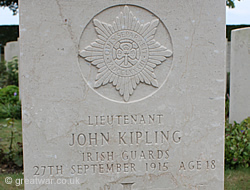
|
John Kipling, the only son of Carrie and Rudyard Kipling and brother to Elsie and Josephine, is buried in this cemetery in Plot VII, Row D, Grave 2.
Having left Wellington College at the age of 16 John enthusiastically answered the call for volunteers to join the British army immediately after the outbreak of war on 4 August 1914. Although John was initially passed over twice for military service due to his eyesight, his father approached his friend Lord Roberts, Colonel-in-Chief of Overseas Forces and first Honorary Colonel of the Irish Guards, to nominate John for an officer's commission in the Irish Guards. The nomination was successful and John joined the regiment in training in September 1914. Almost exactly one year later, promoted to Lieutenant and just turned 18, John was on the battlefield in action with the 2nd Battalion Irish Guards for the first time on the afternoon of 27 September. The battalion was in an attack by the 2nd Guards Brigade in the Guards Division to take the Chalk Pit and Chalk Pit Wood north-east of Loos village. The men went into the attack from 4pm. According to the battalion War Diary John Kipling was wounded and was subsequently missing (1).
In June 1919 the date of John's death was finally confirmed by the British Army Council as 27 September 1915. Like so many thousands of other young men who had died in battle in the Great War of 1914-1918, the whereabouts of his body was unknown. John's parents spent many years searching for news of him by interviewing soldiers, requesting information from the Red Cross and from the German Army through the American embassies in Holland and Germany. Rudyard Kipling died on 18 January 1936 without knowing the whereabouts of his son's grave.
After the war John's name was recorded on the Loos Memorial (Panels 9 and 10) for the missing men of the Irish Guards. In 1992, and again following an internal review in 2015, the Commonwealth War Graves Commission confirmed that the unidentified Irish Guards Lieutenant found in 1919 and buried at St. Mary's ADS Cemetery was Lieutenant John Kipling.
Rudyard Kipling and the Imperial War Graves Commission
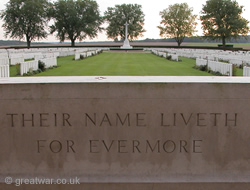
|
As a result of Rudyard's search for John he was inspired to become closely involved with the burial services and commemorative monuments of the Imperial War Graves Commission, now named the Commonwealth War Graves Commission. Rudyard Kipling was invited to become a Commissioner in 1917.
“Their Name Liveth for Evermore”
Rudyard was responsible for suggesting the phrase “Their Name Liveth For Evermore” (2), which was accepted as the inscription for the Stone of Remembrance (also known as the War Stone) found in British and Commonwealth military cemeteries around the world.
“Known unto God”
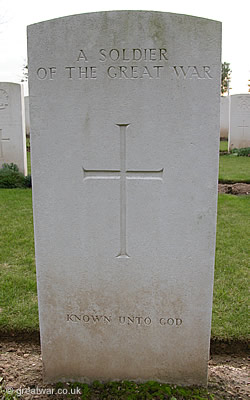
|
Rudyard suggested the words “Known Unto God” for an inscription at the foot of a headstone marking the remains of an unidentified British or Commonwealth soldier. Many thousands of men had been “lost” to their families in the Great War of 1914-1918.
Over 1,500 graves in St. Mary's A.D.S. Cemetery are unidentified and bear the inscription “Known unto God”.
Design of St. Mary's A.D.S. Cemetery
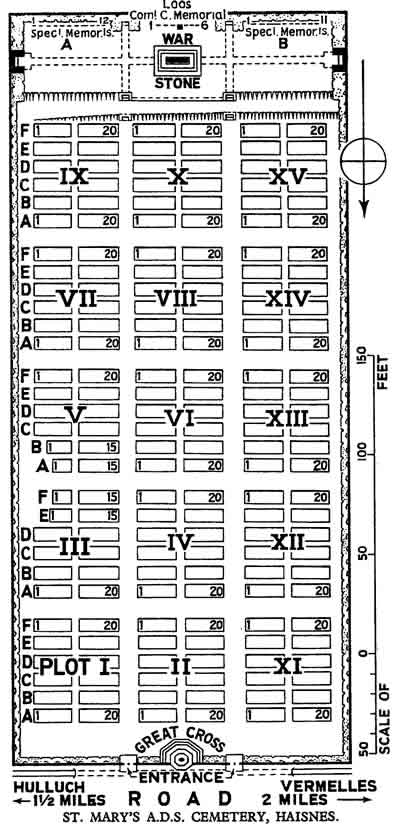
Plan of the Cemetery
The Stone of Remembrance (the War Stone) is located at the southern end of the cemetery (top of the plan shown here).
The Great Cross, the Cross of Sacrifice, is located at the northern end of the cemetery (bottom of the plan shown here), which is the entrance to the cemetery from the Hulluch-Vermelles road.
There are 15 plots identified by Roman numerals I to XV. Each plot contains the remains of 120 casualties laid out in 20 graves in each row. (CWGC)
French Military Cemetery Relocated
By the end of the war a French military cemetery of 800 graves was located on the opposite side of the road to St. Mary's A.D.S. cemetery. The French Army was here from the early weeks of the war until the British Army took over the sector in mid 1915. The French had suffered very high casualties in the spring battles of Artois. In 1922 the graves in the French cemetery were exhumed and removed to the Ablain St-Nazaire “Notre Dame-de-Lorette” French National Cemetery near Souchez.
Ablain St-Nazaire “Notre Dame-de-Lorette” French National Cemetery
Location of St. Mary's A.D.S. Cemetery
St. Mary's A.D.S. Cemetery is located on the Route de Vermelles road from Hulluch to Vermelles. It is north of the village of Loos-en-Gohelle.
Access
The cemetery and memorial are accessible to the public daily and there are no opening hours.
There is a small parking pull off area off the road. Visitors are advised to take care when getting in and out of a car. The road is generally not busy, but vehicles often travel at high speed, and visitors moving around parked cars are advised to be aware of this.
Related Topic
Loos Memorial to the Missing
Names of over 20,000 Missing British and Commonwealth officers and men are inscribed on 139 stone tablets at the Loos Memorial.
Acknowledgements
(1) War Diary of the 2nd Battalion Irish Guards, September 1915. National Archives Reference WO/95/1220.
Website: www.nationalarchives.gov.uk Unit War Diaries
(2) The phrase is taken from Ecclesiasticus, Chapter 44, verse 14: “Their bodies are buried in peace; but their name liveth for evermore”. Source: The King James Bible.
(CWGC) Cemetery plan by kind permission of the Commonwealth War Graves Commission (CWGC). For more information about the Commission and how to find a grave or memorial visit the CWGC website at:
Website: www.cwgc.org

